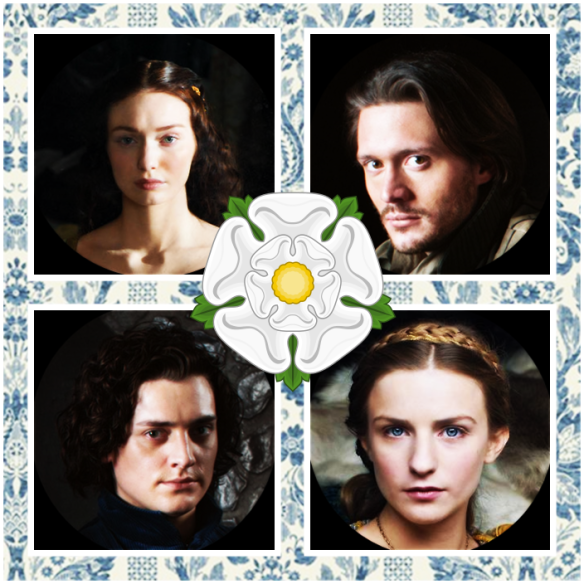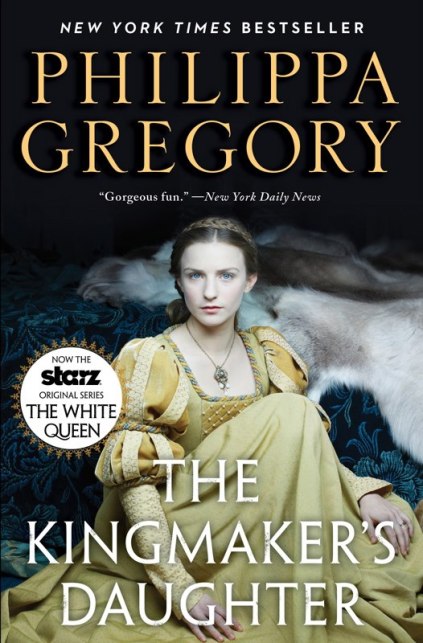The night before the coronation, like monarchs before her, Duchess Anne of Gloucester (born Lady Anne Neville) stayed in The Tower of London. For the procession from the Tower to Westminster on the eve of the ceremony, she wore a kirtle and mantle made from 27 yards of white cloth-of-gold furred with ermine and miniver, and trimmed with lace and tassels of white silk and gold (Laynesmith, p. 92).
On 6 July 1483, The Duke and Duchess of Gloucester were crowned King and Queen of England. Richard and Anne shared a joint coronation. Not since the days of Edward II and Isabel of France had England seen such a magnificent event. The coronation day began at 7 am with a procession on foot from Westminster Hall to the Abbey. For that day, Anne dressed in a robe, curtle, “surcote overt”, and mantle, all of rich purple velvet, furred with ermine, and adorned with rings and tassels of gold; and another suit of crimson velvet, “furred with pure minever”. Her whole purple velvet suit had a fifty-six yard train. (Lawrance)
Both King and Queen had their own separate attendants and train. Lady FitzHugh (born Lady Alice Neville) and her daughter Lady Parr (born Elizabeth FitzHugh) were two of the seven noble ladies to ride behind the queen. Lady FitzHugh was an aunt to Queen Anne and a cousin to King Richard. These two ladies were of course great-grandmother and grandmother to another queen consort, Katherine Parr. Both were dressed in fine dresses made by cloth that the King himself had given them. Lady Parr received seven yards of gold and silk; her mother received material for two gowns, one of blue velvet and crimson satin as well as one of crimson and velvet with white damask. As befitting of a Baroness, eight yards of scarlet cloth was given for mantles on the occasion. Lord Parr (Sir William Parr) chose not to attend the coronation despite being given a position as canopy bearer. Lord Parr had been a staunch supporter of King Edward IV through whom he rose.
In an attempt to conciliate with the Lancastrians, the trains of both the King and Queen were carried by the two lineal representatives of the house, the Duke of Buckingham and the Countess of Richmond [Lady Margaret Beaufort]. (Lawrance)
An account from “The National and Domestic History of England“:
After the procession of the king followed that of his queen Anne [Neville]. The earl of Huntingdon bore her sceptre, the viscount Lisle the rod and dove, and the earl of Wiltshire her crown. Then came the queen herself habited in robes of purple velvet furred with ermine having on her head a circlet of gold with many precious stones set therein. Over her head was borne a cloth of estate. On one side of her walked the bishop of Exeter on the other the bishop of Norwich. A princess of the blood, the celebrated Margaret, countess of Richmond, mother of Henry VII supported her train. After the queen walked the king’s sister Elizabeth, duchess of Suffolk, having on her head a circlet of gold and after her followed a train of highborn ladies succeeded by a number of knights and esquires. Entering the abbey at the great west door the king and queen took their seats of state staying till divers holy hymns were sung when they ascended to the high altar where the ceremony of anointing took place. Then the king and queen put off their robes and there stood all naked from the middle upwards and anon the bishop anointed both the king and the queen. This ceremony having been performed, they exchanged their mantles of purple velvet for robes of cloth of gold and were solemnly crowned by the archbishop of Canterbury assisted by the other bishops. The archbishop subsequently performed high mass and administered the holy communion to the king and queen after which they offered at St Edward’s shrine where the king laid down King Edward’s crown and put on another and so returned to Westminster Hall in the same state they came.
The banquet, which took place at four o clock in the great hall, is described as having been magnificent in the extreme. The king and queen were served on dishes of gold and silver. Lord Audley performed the office of state carver. Thomas Lord Scrope that of cupbearer. Lord Lovel, during the entertainment, stood before the king, “two esquires lying under the board at the king’s feet.” On each side of the queen stood a countess with a plaisance or napkin for her use. Over the head of each was held a canopy supported by peers and peeresses. The guests consisted of the cardinal archbishop the lord chancellor, the prelates, the judges, and nobles of the land, and the Lord Mayor, and principal citizens of London. The ladies sat by themselves on both sides of a long table in the middle of the hall. As soon as the second course was put on the table, the king’s champion Sir Robert Dymoke rode into the hall; his horse being trapped with white silk and red and himself in white harness the heralds of arms standing upon a stage among all the company. Then the king’s champion rode up before the king asking all the people if there was any man would say against King Richard III why he should not claim the crown. And when he had said so all the hall cried King Richard with one voice. And when this was done anon, one of the lords brought unto the champion a covered cup full of red wine and so he took the cup aud uncovered it and drank thereof. And when he had done anon he cast out the wine and covered the cup again and making his obeisance to the king turned his horse about and rode through the hall with his cup in his right hand and that he had for his labour. Then Garter king at arms supported by eighteen other heralds advanced before the king and solemnly proclaimed his style and titles. No single untoward accident marred the harmony or splendour of the day. When at length began to close the hall was illuminated by great light of wax torches and cressets apparently the signal for the king and queen to retire. Accordingly wafers and hipocras been previously served Richard and his rose up and departed to their private apartments in the palace. (Aubrey)

Aneurin Barnard as King Richard III and Faye Marsay and Queen Anne. Fictional portrayal in Philippa Gregory’s “The White Queen” (2013).
Sources
- William Hickman S. Aubrey. “The National and Domestic History of England,” 1878. pg 193-4.
- Hannah Lawrance. “Historical Memoirs of the Queens of England from the Commencement of the Twelfth Century,” Volume 2, Moxon, 1840.













